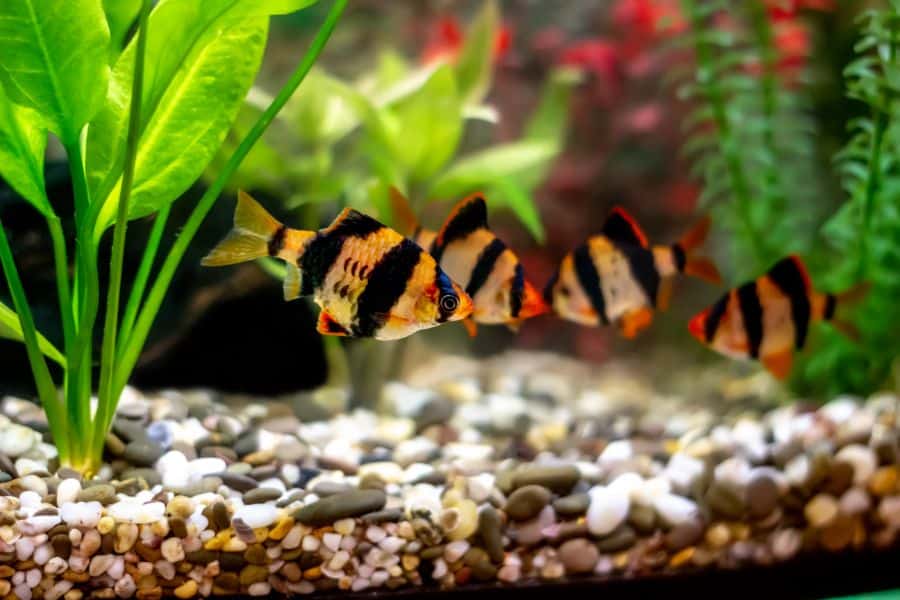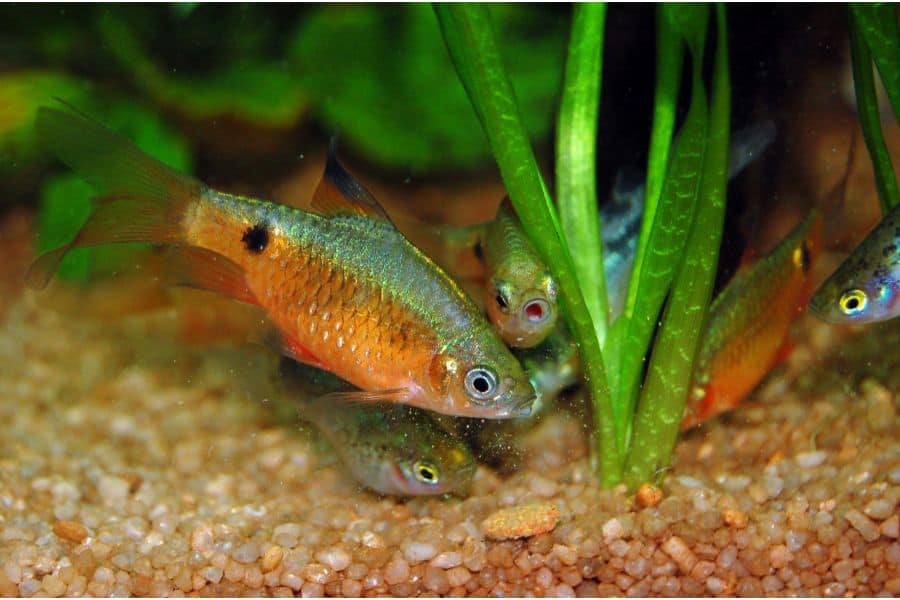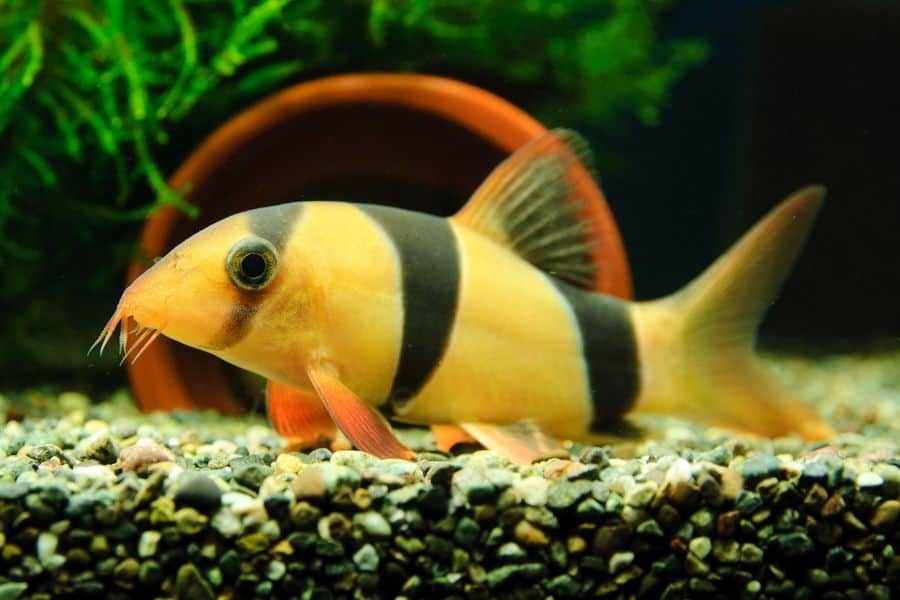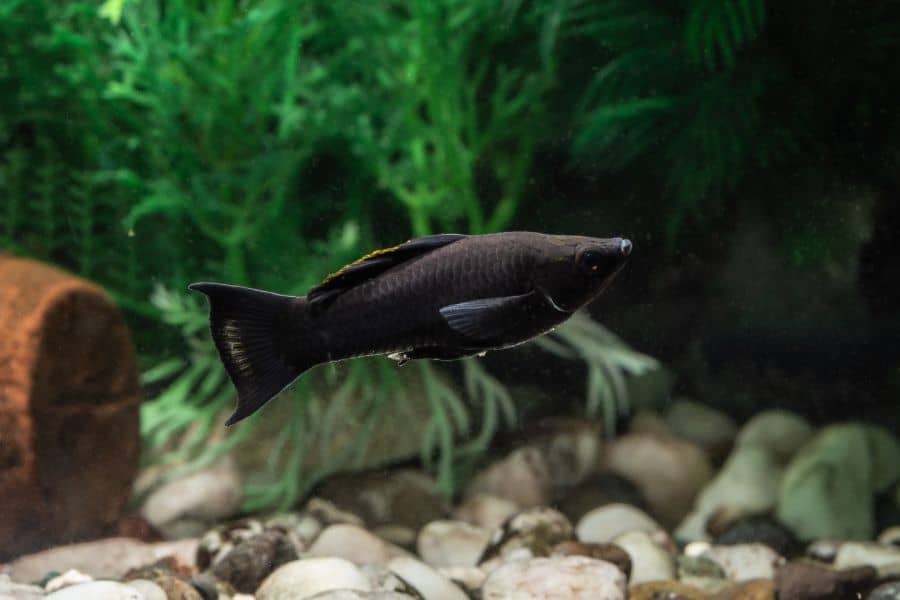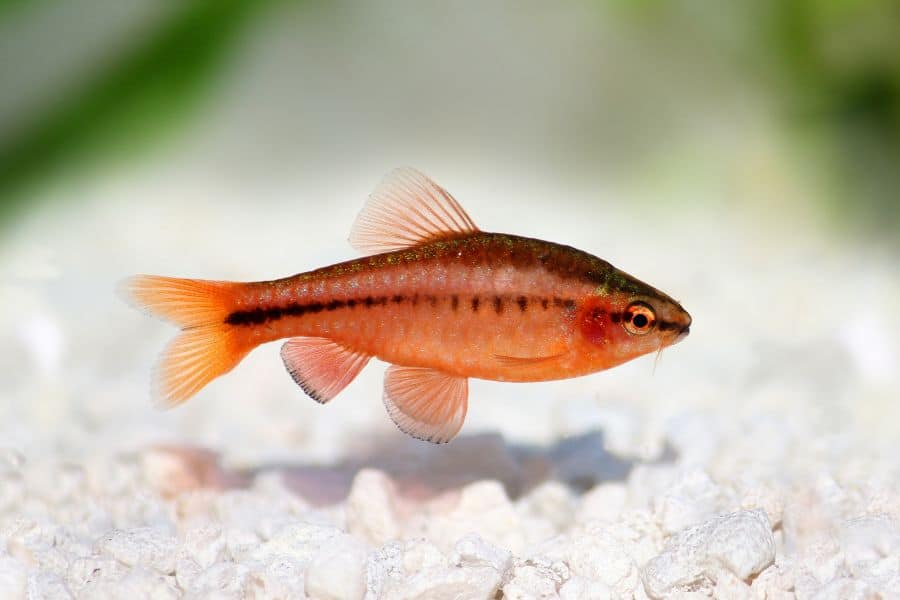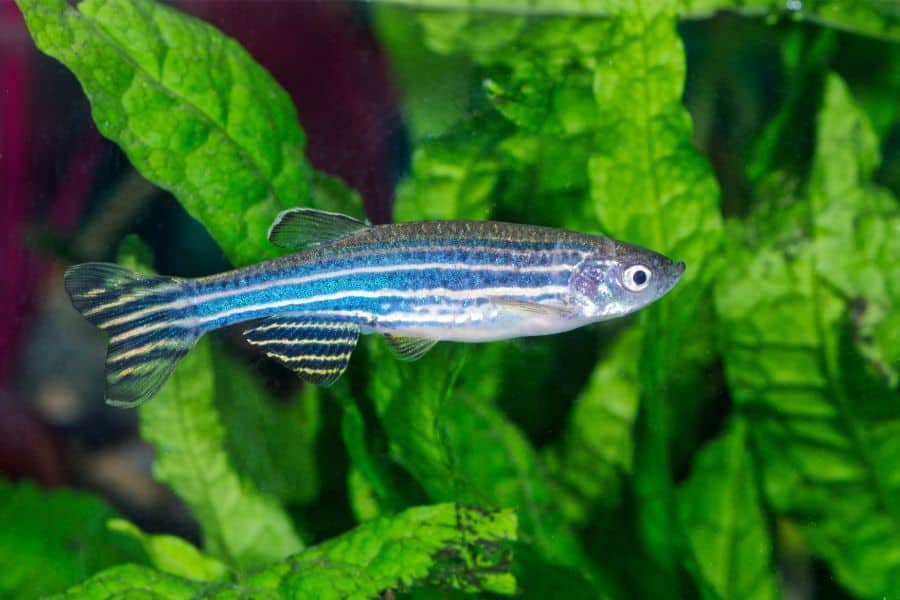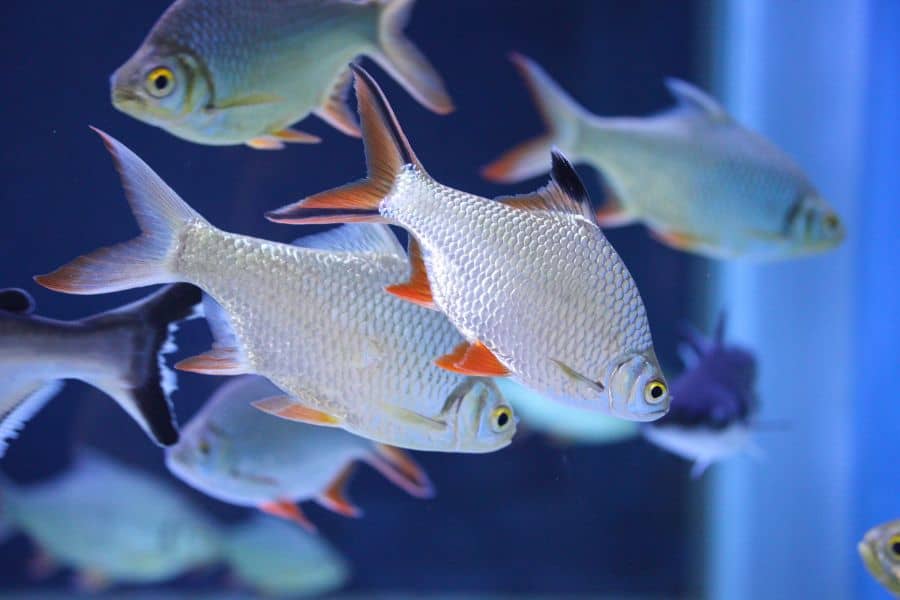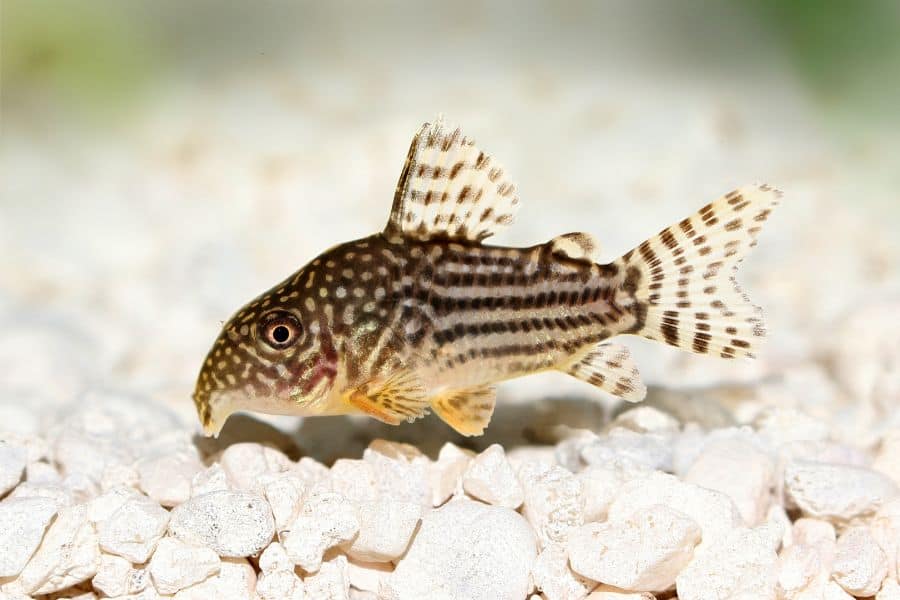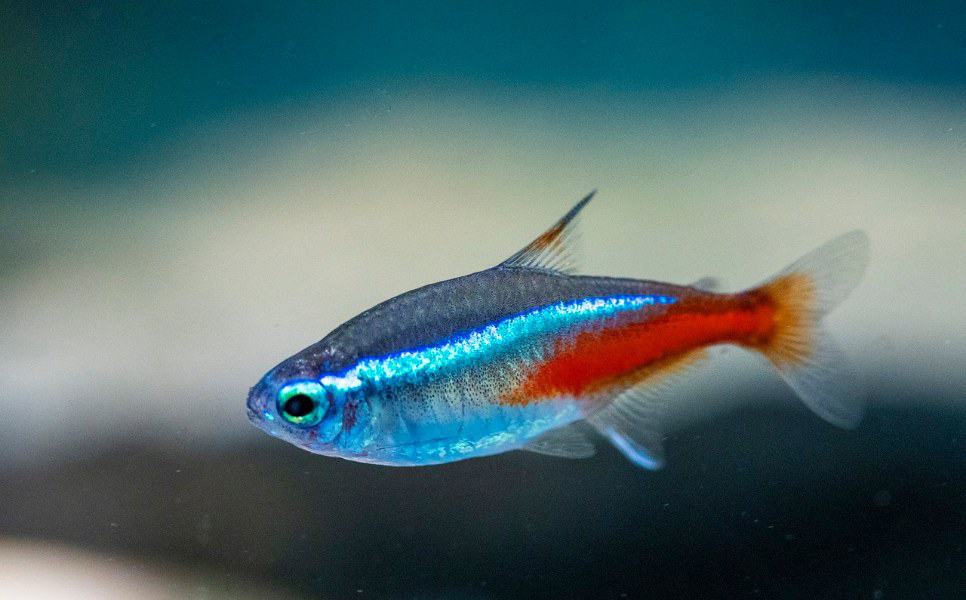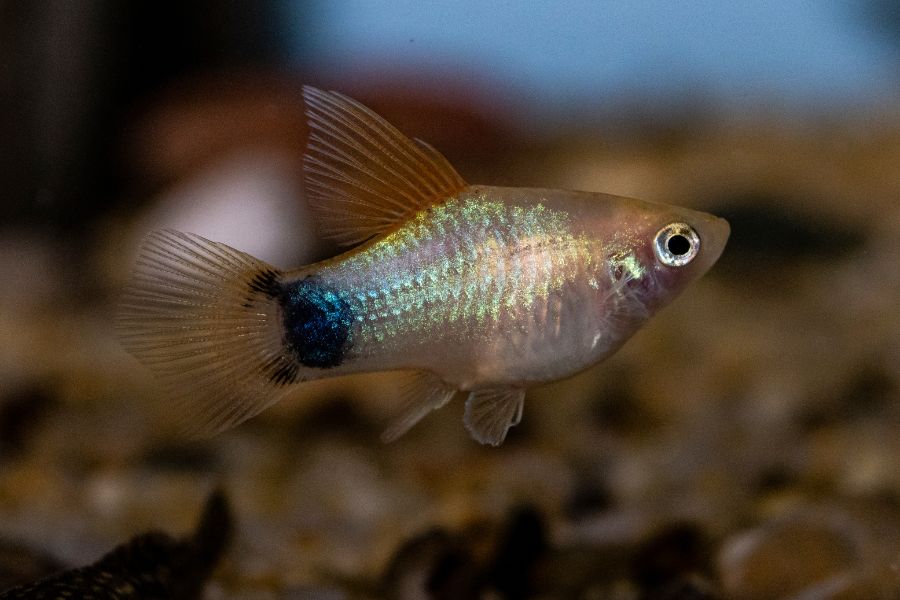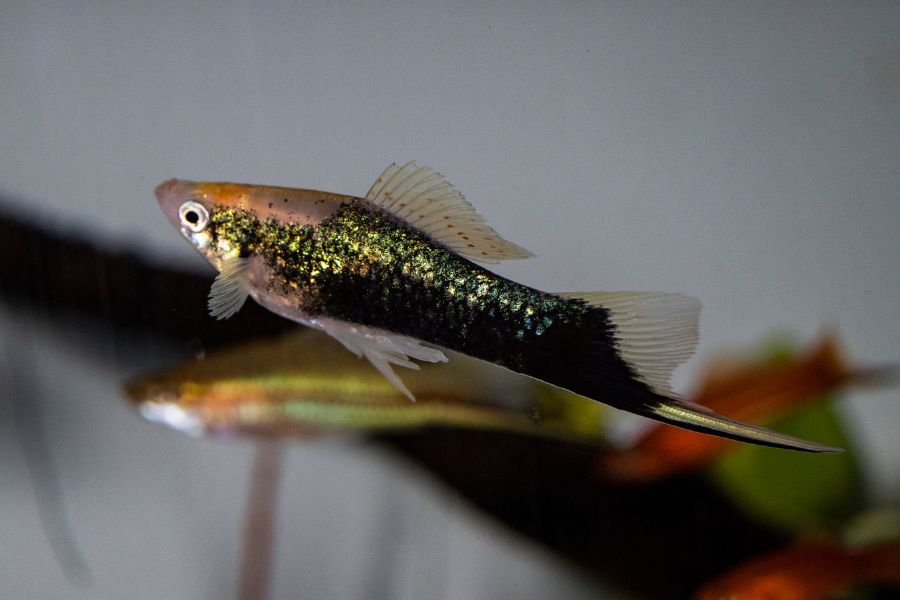Due to their distinctive body stripes, many species have originated from a tiger’s name. One of them is the tiger barb (Puntius tetrazona).
The four black vertical bands of this freshwater fish are surprisingly associated with the body stripes of a Sumatran tiger, thus earning it another name: the Sumatra barb.
Aside from stripes, the temper of tiger barbs can also be linked with the behavior of the world’s biggest cat.
Yes, tiger barbs are aggressive. But it does not mean they should be placed in a single-species tank and live alone. Just like the coexistence of tigers with other species in the wild, tiger barbs can live in harmony with some fish.
Join us in this article as we present the ideal tank mates for this small but hostile fish.
Tips for Harmonious Rearing of Tiger Barb with Other Fish
The reason why some hobbyists refrain from keeping tiger barbs is their temper. While some do keep them, they usually place them in isolation.
It should not be the case.
Tiger barbs are lovely and colorful fish. They should thrive along with their compatible species. However, in doing so, you have to observe the following steps:
Keep Them in School
In general, successful predators are solitary hunters. Without the distraction of others, predators can focus on their target.
In the case of the tiger barb, their aggression will grow if they are left alone in solitary confinement. However, when you rear them in a school (at least in groups of 6 fish), aggression will turn to socialization.
A good indicator that aggression is curbing is when they start swimming in groups, especially when you can see a clear swimming pattern and direction.
Keep Fish of Similar Size
Size does matter, especially to who’s dominating the aquarium. Tiger barbs are aggressive to any fish smaller than them.
To contain aggression, you must keep tiger barbs along with fish that have a similar size. Better if other fish residents are larger than tiger barbs.
For reference, the size of tiger barbs ranges from 7 to 10 cm (3 to 4 inches) in length.
Avoid Fellow Aggressive Fish
They say aggression itself cures aggression. When two aggressive species cross paths, one species will give way. But this is not the case for tiger barbs.
In the presence of another aggressive fish, tiger barb aggression surges. Often, it leads to a full-blown fight. The end game is that one species will succumb, and the consequences are sometimes fatal.
Avoid Long-Fin Species
Fin nipping is a common manifestation of tiger barb aggression. When you have a long-fin fish, this entices them to nip.
Initially, fin-nipping can be considered a sign of curiosity. However, if frequently done, this will become a habit, and fin-nipping may not require aggression anymore. They might even do it with larger species of fish.
Provide Ample Swimming Space
Considering that you are keeping a school of tiger barbs plus other compatible fish residents, ample living and swimming space is mandatory.
The least that you can use is a 20-gallon tank. Not only will it provide abundant swimming space, you will also have room for live aquatic plants.
Choose Fish with Similar Tank Requirements
What’s the point of providing your tiger barb with a tank mate when they are incompatible in their thriving conditions?
Choose a fish that has a similar tank requirement with tiger barbs, like:
- Temperature: 21 to 27C (70 to 80F)
- pH: 6 to 7
- Hardness: 10 dGH
There are a lot of articles about the best tank mates for tiger barbs. However, most of them fail to describe their degree of compatibility.
In our case, we developed a compatibility checklist to show that the species we’re presenting are compatible with tiger barbs. While there are many parameters to be considered, the parameters we have chosen are the most crucial.
The perfect tank mate for tiger barbs should have an overwhelming compatibility remark of 5/5 as described below:
| Species Compatibility = 5/5 | ||
| Parameters | Range | Remarks |
| Body Size | 7cm (3 in) or more | Compatible |
| Tank Conditions – Temperature – pH |
21 to 27C (70 to 80F) 6 to 7 |
Compatible Compatible |
| Fin Size | Short | Compatible |
| Behavior | Peaceful | Compatible |
Best Tank Mates for Tiger Barbs
Rosy Barb (Pethia conchonius)
Coming from the same family of barb fish, tiger barbs and rosy barbs are perfectly compatible in all aspects.
While rosy barbs are large, they have short fins and discourage the fin-nipping cravings of tiger barbs.
Both fish are schooling and require a similar tank condition. Although you have to be careful about temperature as the rosy barb range sits on the lower limit of those needed by tiger barbs.
| Rosy Barb Compatibility = 5/5 | ||
| Parameters | Range | Remarks |
| Body Size | 10 to 15 cm (4 to 6 in) | Compatible |
| Tank Conditions – Temperature – pH |
18 to 22C (65 to 72F) 6 to 7 |
Compatible Compatible |
| Fin Size | Short | Compatible |
| Behavior | Peaceful | Compatible |
Pictus Catfish (Pimelodus pictus)
Originating from the Amazon rainforest, the Pictus catfish is another perfect tank mate for tiger barb. It has an excellent compatibility rating of 5/5.
The body size of this catfish is closely similar to tiger barbs, and their tank requirements are identical.
Adding to its perfect compatibility, Pictus catfish occupy the substrate zone in the aquarium. Seldom do they meet face-to-face with tiger barbs.
| Pictus Catfish Compatibility = 5/5 | ||
| Parameters | Range | Remarks |
| Body Size | 7 to 13 cm (3 to 5 in) | Compatible |
| Tank Conditions – Temperature – pH |
24 to 27C (75 to 80F) 7 to 7.5 |
Compatible Compatible |
| Fin Size | Short | Compatible |
| Behavior | Peaceful | Compatible |
Common Pleco (Hypostomus plecostomus)
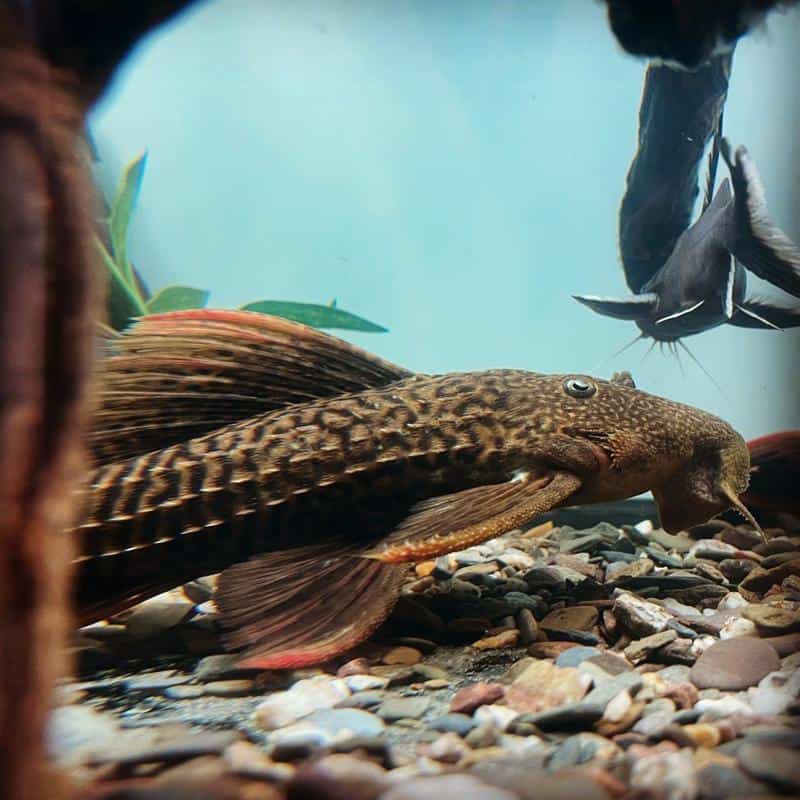
Also known as suckermouth catfish, we all know that common plecos are an aquarium asset as they eat and control the unwanted growth of algae.
But do you know common plecos are also the perfect tank mates for tiger barbs?
In all aspects, they are compatible. Temper-wise, common plecos are peaceful and focus on cleaning your aquarium against algae. When it comes to size, tiger barbs are dwarfed by their size as they can grow up to a third of a meter.
| Common Plecostomus Compatibility = 5/5 | ||
| Parameters | Range | Remarks |
| Body Size | 30 to 40 cm (12 to 16 in) | Compatible |
| Tank Conditions – Temperature – pH |
23 to 27C (74 to 80F) 7 to 8 |
Compatible Compatible |
| Fin Size | Short | Compatible |
| Behavior | Peaceful | Compatible |
Clown Loach (Chromobotia macracanthus)
Clown loaches are entertainers. Their ability to swim upside down is unique to this scaleless fish. They can even lie motionless on the substrate and play dead.
On top of their impressive skill, they are also a perfect match for tiger barbs. From body size, tank conditions, and behavior, clown loaches, and tiger barbs are aquarium buddies.
Just be aware that sometimes you may have a hard time finding them. And please don’t think tiger barbs have consumed them. Maybe they are hiding in rocks or under the decor as it is their habit.
| Clown Loach Compatibility = 5/5 | ||
| Parameters | Range | Remarks |
| Body Size | 20 to 30 cm (8 to 12 in) | Compatible |
| Tank Conditions – Temperature – pH |
24 to 30C (75 to 86F) 5 to 8 |
Compatible Compatible |
| Fin Size | Short | Compatible |
| Behavior | Peaceful | Compatible |
Black Molly (Poecilia sphenops)
If you look closely at the parameters, black mollies are perfect tank mates for tiger barbs.
However, you have to be aware of one thing.
Traditionally, molly tanks are small, like a 10-gallon tank. They can even survive living in a fish bowl. The trick here is you should follow the tank size requirement of tiger barbs which is at least 20 gallons.
| Black Molly Compatibility = 5/5 | ||
| Parameters | Range | Remarks |
| Body Size | 8 to 12 cm (3 to 5 in) | Compatible |
| Tank Conditions – Temperature – pH |
24 to 30C (75 to 86F) 7 to 8 |
Compatible Compatible |
| Fin Size | Short | Compatible |
| Behavior | Peaceful | Compatible |
Cherry Barb (Puntius titteya)
At a glance, tiger barbs and cherry barbs seem the perfect tank mate. Both fish are closely related and belong to the same family of barb fish (Cyprinidae). They are almost perfectly compatible. Except that cherry barbs are smaller than tiger barbs.
Despite their difference in size, it does not mean that cherry barbs and tiger barbs are incompatible.
Yes, they are still compatible. Both fish are schooling, and the need for live aquatic plants by cherry barbs gives them a refuge to hide whenever tiger barb aggression goes out of control.
| Cherry Barb Compatibility = 4/5 | ||
| Parameters | Range | Remarks |
| Body Size | 3 to 5 cm (1 to 2 in) | Incompatible |
| Tank Conditions – Temperature – pH |
22 to 27C (73 to 80F) 6 to 8 |
Compatible Compatible |
| Fin Size | Short | Compatible |
| Behavior | Peaceful | Compatible |
Zebrafish (Danio rerio)
Zebrafish is another small-sized fish compatible with tiger barbs. They are so small that tiger barbs don’t bother them.
What you should keep in mind is their tolerance to a wide range of temperature environments.
In the wild, they live in near-freezing waters (4 C / 39 F) and the warm waters of the tropics (up to 41 C / 106 F). In an aquarium setting, they prefer anywhere from 15 to 27 C (60 to 80 F).
So, adjust the temperature for zebrafish and tiger barbs to survive and co-exist.
| Zebrafish Compatibility = 4/5 | ||
| Parameters | Range | Remarks |
| Body Size | 2 to 4 cm (1 to 1.5 in) | Incompatible |
| Tank Conditions – Temperature – pH |
15 to 27C (60 to 80F) 7 to 8 |
Compatible Compatible |
| Fin Size | Short | Compatible |
| Behavior | Peaceful | Compatible |
Tinfoil Barb (Barbonymus schwanefeldii)
Contrary to the size inferiority of cherry barbs, tinfoil barbs are superior to tiger barbs as they can grow up to 35 cm (14 in) in length. They have a voracious appetite allowing them to grow fast.
Tinfoil barbs are fast swimmers. They may pursue smaller fish (in this case, the tiger barbs) and nip their fins. Provided you don’t starve them, they will leave others in peace.
The good thing with tinfoil barbs is they require a large tank (at least 70 gallons). In effect, tiger barbs will have more space for schooling and swimming.
| Tinfoil Barb Compatibility = 4/5 | ||
| Parameters | Range | Remarks |
| Body Size | 25 to 35 cm (10 to 14 in) | Compatible |
| Tank Conditions – Temperature – pH |
22 to 25C (72 to 77F) 6.5 to 7 |
Compatible Compatible |
| Fin Size | Short | Compatible |
| Behavior | Aggressive to smaller fish | Incompatible |
Cory Catfish (Corydoras melanotaenia)
Being peaceful and non-aggressive, cory catfish are compatible with tiger barbs. Their tank requirements are similar to those of tiger barbs.
If only they grow bigger, cory catfish could be a perfect tank mate for tiger barbs. They are slightly smaller than tiger barbs. But this poses no problem since they occupy a specific part of the aquarium.
While tiger barbs love to swim midwater, cory catfish prefer the substrate. As omnivorous scavengers, they scour the bed for dead plants, animals, and leftover feed.
| Cory Catfish Compatibility = 4/5 | ||
| Parameters | Range | Remarks |
| Body Size | 4 to 6 cm (1.5 to 2 in) | Incompatible |
| Tank Conditions – Temperature – pH |
23 to 25C (73 to 77F) 6 to 8 |
Compatible Compatible |
| Fin Size | Short | Compatible |
| Behavior | Peaceful | Compatible |
Neon Tetra (Paracheirodon innesi)
Neon tetras are one of the few small-sized fish still compatible with tiger barbs.
With a body length of only 4 cm (1.5 in), they are so small that tiger barbs don’t bother to disturb them. However, only introduce them to tiger barbs in tanks with live plants. When the tiger barb’s temper is triggered, they have a place to hide.
Other than their size, the rest of the parameters are compatible and similar to those of tiger barbs.
| Neon Tetra Compatibility = 4/5 | ||
| Parameters | Range | Remarks |
| Body Size | 2 to 4 cm (0.7 to 1.5 in) | Incompatible |
| Tank Conditions – Temperature – pH |
24 to 27 C (75 to 80 F) 6 to 7 |
Compatible Compatible |
| Fin Size | Short | Compatible |
| Behavior | Peaceful | Compatible |
Red Tail Shark (Epalzeorhynchos bicolor)

Related to carp and barbs, red tail sharks are not real sharks.
But they are aggressive, especially to their kind, particularly of the same size. So, limit their numbers.
Your tiger barbs should be smaller than the red tail sharks. In this way, you can have a peaceful and fight-free aquarium.
| Red Tail Shark Compatibility = 4/5 | ||
| Parameters | Range | Remarks |
| Body Size | 10 to 13 cm (4 to 5 in) | Compatible |
| Tank Conditions – Temperature – pH |
22 to 26C (71 to 79F) 6 to 8 |
Compatible Compatible |
| Fin Size | Short | Compatible |
| Behavior | Aggressive | Incompatible |
Platy (Xiphophorus maculatus)
Aside from being known as a community fish, platies are great tank mates for tiger barbs. The water conditions they require are almost identical to those with tiger barbs.
Everything is a perfect match except for two things.
First, their temperature preference sits on the lower limit of the tiger barb’s requirement. The surrounding water temperature may be okay for platies, but it may be cold for your tiger barbs.
The second is size. Platies are slightly smaller than tiger barbs. There is a tendency that your tiger barb will nip on your platy’s fins. Provide live plants as hiding places.
| Platy Compatibility = 4/5 | ||
| Parameters | Range | Remarks |
| Body Size | 4 to 6 cm (1.5 to 2.5 in) | Incompatible |
| Tank Conditions – Temperature – pH |
20 to 25C (68 to 77F) 7 to 8 |
Compatible Compatible |
| Fin Size | Short | Compatible |
| Behavior | Peaceful | Compatible |
Related: Platy and Molly: Similarities and Differences
Swordtail (Xiphophorus hellerii)
The name swordtail comes from their elongated lower caudal fin that looks like a sword. It is very distinct that even kids can identify them at the pet shop.
While their tails are an asset in taxonomy, it is a liability when living with tiger barbs. When tiger barb aggression spikes, their protruding tail is often the primary target for nipping.
Aside from their long caudal fins, swordtails are great tank mates for tiger barbs.
| Swordtail Compatibility = 4/5 | ||
| Parameters | Range | Remarks |
| Body Size | 10 to 16 cm (4 to 6 in) | Compatible |
| Tank Conditions – Temperature – pH |
20 to 28C (60 to 82F) 7 to 8 |
Compatible Compatible |
| Fin Size | Long | Incompatible |
| Behavior | Peaceful / Aggressive | Compatible |
Read More:
FAQs
What Are the Worst Tank Mates for Tiger Barbs?
Any aggressive fish or fish with long decorative fins will not work well with tiger barbs. A perfect example of this is the bettas.
While goldfish and angelfish are peaceful, their long fins will always attract the attention of tiger barbs.
What Triggers Tiger Barb Aggression?
Aside from the compatibility parameters we have presented, the hierarchy between males is often associated with aggression.
If you see two or more tiger barbs chasing and nipping each other, most probably those are males fighting for their throne.
How Do You Distinguish a Male from A Female Tiger Barb?
Male tiger barbs are smaller, slimmer, and more colorful than females. Focusing on their stripes, the females have a soft color tone, especially in the mouth and nose areas.
Conclusion
In support to the compatibility checklist we have made in this article, the species we listed here are already proven.
Their tandem has sparked interest for both expert and novice aquarists. But even seasoned hobbyists will tell you: always watch out for fin nipping, as tiger barbs are notoriously known for this habit.
